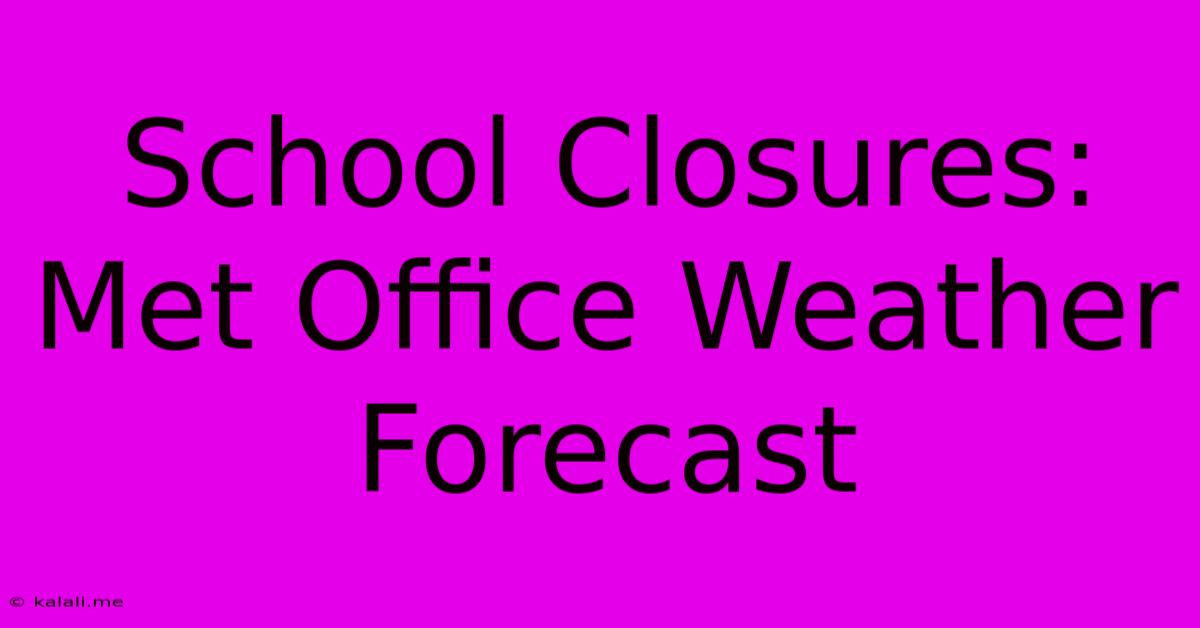School Closures: Met Office Weather Forecast
Kalali
Jan 10, 2025 · 4 min read

Table of Contents
School Closures: Met Office Weather Forecast
The Met Office, the UK's national weather service, plays a crucial role in informing decisions about school closures, especially during severe weather events. Understanding how the Met Office's forecasts influence these decisions is vital for parents, students, and school administrators alike. This article delves into the complex relationship between Met Office weather forecasts and school closures, exploring the factors considered, the challenges involved, and the evolving role of technology in this process.
Understanding the Met Office's Role
The Met Office doesn't directly order school closures. Their role is to provide accurate and timely weather information, including warnings and forecasts, which local authorities and individual schools then use to make informed decisions. This information is crucial because severe weather conditions can pose significant risks:
- Travel safety: Icy roads, heavy snow, flooding, and high winds can make travel extremely dangerous for students and staff commuting to school.
- Building safety: Strong winds, heavy snowfall, or flooding can damage school buildings, posing safety risks to those inside.
- Student safety: Exposure to extreme weather conditions can lead to hypothermia, injuries, and other health problems.
Types of Met Office Warnings
The Met Office issues various weather warnings, categorized by severity:
- Yellow warnings: These indicate that the weather could be disruptive. Schools might monitor the situation but usually remain open.
- Amber warnings: These signify a greater likelihood of significant disruption and potential danger. School closures become more likely at this level.
- Red warnings: These indicate a severe weather event with a high likelihood of significant disruption and danger to life. School closures are almost certain under red warnings.
Factors Influencing School Closure Decisions
While Met Office warnings are a key factor, several other elements influence a school's decision to close:
- Local conditions: Even with a national warning, local conditions can vary significantly. A school in a higher-altitude area might experience heavier snowfall than a school in a lower-lying area.
- School infrastructure: Schools with older buildings or inadequate heating might be more vulnerable to severe weather and thus more likely to close.
- Transport links: The reliability of public transport and the accessibility of roads greatly influence the decision-making process. If bus routes are disrupted, a school might choose to close, even with a less severe warning.
- Staffing levels: If a significant portion of staff cannot safely reach the school, closure becomes more likely.
- Risk assessment: Schools conduct risk assessments to identify potential hazards associated with severe weather and implement mitigation strategies. These assessments inform the decision-making process.
The Role of Local Authorities
Local authorities often play a coordinating role, particularly in areas affected by widespread severe weather. They might advise schools to close based on a combination of Met Office warnings, local conditions, and transport disruptions. Their role ensures a consistent approach across different schools within the area.
Communicating School Closures
Effective communication is vital during school closures. Schools typically utilize various methods:
- School website: The school website is usually the first point of contact, providing updates and announcements.
- Email alerts: Parents and staff often receive email alerts directly from the school.
- Social media: Schools might utilize social media platforms such as Twitter or Facebook to disseminate information quickly.
- Local media: Local radio and television stations often broadcast information about school closures.
The Impact of Technology
Technological advancements have significantly improved the accuracy and dissemination of weather information, aiding school closure decisions. Improved forecasting models, advanced weather radar, and real-time data analysis contribute to more precise predictions. Furthermore, mobile apps and online platforms provide immediate access to weather warnings and school closure announcements.
Future Trends
The future of school closure decisions is likely to involve further integration of technology and data analysis. This could include:
- More sophisticated forecasting models: Predicting local weather conditions with even greater accuracy.
- Automated alert systems: Automatically triggering school closures based on pre-defined criteria.
- Data-driven decision-making: Analyzing historical data on weather patterns and school closures to optimize decision-making.
- Improved communication channels: Ensuring everyone has access to timely and accurate information.
The Importance of Preparedness
Regardless of the technological advancements, preparedness remains crucial. Both schools and families should have plans in place for severe weather events:
- Emergency contact information: Ensure that emergency contact details are up-to-date.
- Emergency supplies: Have essential supplies on hand, including food, water, and medications.
- Communication plan: Establish a communication plan for families to stay connected during severe weather events.
Conclusion: A Collaborative Effort
School closures due to severe weather are a complex issue, requiring a collaborative effort between the Met Office, local authorities, schools, and families. By leveraging advanced forecasting technology, strengthening communication channels, and maintaining a focus on safety, communities can effectively manage disruptions caused by inclement weather and ensure the well-being of students and staff. The Met Office's weather forecasts are a crucial component of this process, providing the essential data that underpins informed decision-making. Understanding the intricacies of this system allows for better preparedness and response during challenging weather events.
Latest Posts
Latest Posts
-
What Does We We Mean In French
Jul 06, 2025
-
What Is Three Score Cubits In Feet
Jul 06, 2025
-
What Is 1 2 Of 1 5
Jul 06, 2025
-
Words To Somewhere Over The Rainbow Judy Garland
Jul 06, 2025
-
How Old Am I If Born In 1986
Jul 06, 2025
Related Post
Thank you for visiting our website which covers about School Closures: Met Office Weather Forecast . We hope the information provided has been useful to you. Feel free to contact us if you have any questions or need further assistance. See you next time and don't miss to bookmark.